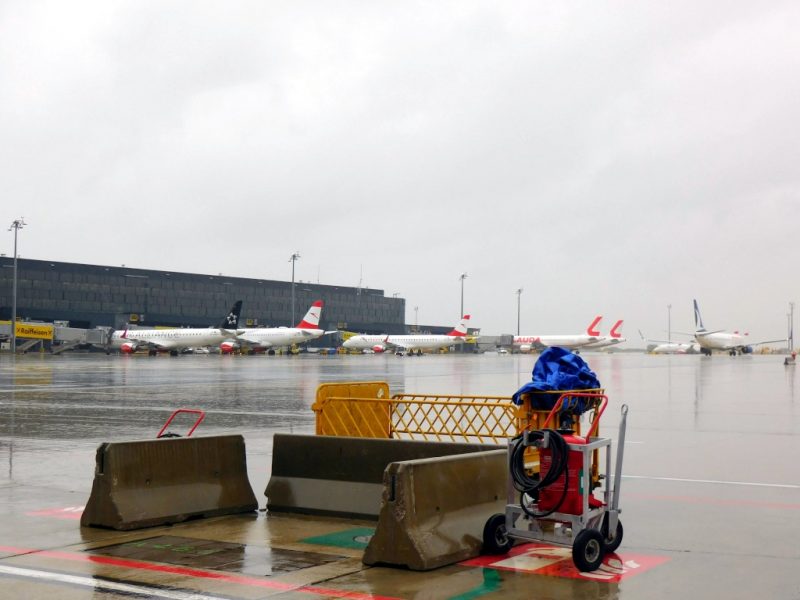In commercial scheduled traffic, things are not going badly at the moment, but literally miserable: The random check of the flight utilization at Vienna Airport over the weekend clearly shows that even combat travel offers in the single-digit euro range cannot stimulate demand.
Not only Austrian Airlines, but also low-cost competitors such as Wizzair, Ryanair / Lauda, Easyjet and literally stay seated on their flight tickets. In depth, of course, the justified question immediately arises: How long can and will the providers operating at Vienna Airport still afford the miserable sales and thus disastrous income?
Ryanair and her daughter Lauda had an average of 30 to 40 passengers per flight on board at the weekend. The type of aircraft used by Lauda, the Airbus A320, has 180 seats, resulting in a load factor of 16,67-22,22 percent. In other words, around 80 percent of the seats in the Lauda machines were empty. On those flights that were served with Boeing 737s operated by Ryanair, Buzz or Malta Air, the load factor looks even worse, as the model has 189 seats. The Boeing 738-800 has an average load factor of 15,87-21,16 percent. On Sunday the route FR7361 (Bergamo-Vienna) with around 60 passengers (around 31,75 percent load) was a positive exception. The Vienna flight plan was only a few days ago drastically reduced.
At the Lufthansa subsidiaries Eurowings and Swiss there were even fewer passengers on board. On average there were around 20 passengers per flight. The percentage utilization for an A144 with 319 seats is shown as an example: 13,89 percent. In other words: over 86 percent of the seats were empty. Eurowings currently has all flights to Vienna, with the exception of Düsseldorf and Hamburg, temporarily discontinued.
Turkish Airlines was able to achieve the best occupancy at the weekend, as there were an average of 150 passengers on the flights. The Boeing 737 machine type was used, so that one could almost, but only almost, believe that there is no crisis. Unfortunately, the weekend was only a “positive slip” for Turkish, because otherwise you struggle in Vienna with weak demand and the resulting poor occupancy rate.
The Austrian Airlines The load factor was very different, but there were only a few flights with more than 50 passengers on board. An exception was the Shanghai flight with around 120 passengers. Taking into account the fact that the Boeing 767-300ER has 211 seats with this airline, the load factor was around 56,87 percent. That was the positive exception, however, because the OS195 course carried out with the Embraer 156 only had about 20 passengers on board on Sunday. This type of machine has 112 seats at the AUA, so that the load factor was around 17 percent. In other words: 83 percent of the seats remained empty.
However, this was not an “isolated case”, because OS172, OS174, OS213, OS576, OS376 had so few passengers on board, to name a few more examples. On the courses that were carried out with the Airbus A319 (130 seats), the average occupancy was around 15,38 percent, i.e. around 84 percent of the seats remained empty. The flights, which were operated with turboprop aircraft of the type DHC Dash 8-400 (72 seats), the load factor was around 27,78 percent - around 73 percent of the seats remained free. The OS306 course, carried out with an A320 (160 seats), had around 40 passengers on board, load factor: 25 percent - 75 percent empty seats.
Flight OS632 (Warsaw-Vienna), for example, was better utilized with around 60 passengers in the Embraer 195. With a load factor of 53,57 percent, the aircraft was roughly half full. In the DHC Dash 8-400 from Bologna to Vienna there were around 40 passengers on Sunday, which means a load factor of around 55,56 percent for this type of machine. In view of the fact that all airlines are currently selling their tickets very cheaply, these values are also too weak to be able to fly economically. It is very likely that the yield is higher than in the Ryanair 737, but it will not be enough. On Sunday the AUA courses OS902 (Innsbruck-Vienna) and OS810 (Thessaloniki-Vienna) even had fewer than 20 passengers on board, so that it clearly shows that it currently does not matter whether the tickets are sold in the single-digit euro range or between 50 and 100 euros are offered, the demand does not seem to exist.
The Easyjet However, things are not going any better either. The average load factor on the routes offered from Vienna is completely comparable and almost identical to that of the competitors. The course EZS1193 from Basel to Vienna marked the absolute low point at the weekend with fewer than 20 passengers. Easyjet Switzerland announced a few days ago that the Basel base was going to be two machines is downsized and staff also has to be cut. Easyjet is also reducing its route network and can reduce further capacity do not exclude.
The utilization at Wizzair does not differ from those of the competitors. On average there are around 30 to 40 passengers, sometimes significantly fewer, sometimes a little more, on board. This carrier is currently mainly using Airbus A320 aircraft with 180 seats from Vienna. The load factor is almost the same as that of the Lauda A320. The fact that Ryanair / Lauda and Wizzair sell flight tickets in the single-digit euro range on a large scale, sometimes even from five euros, but still so many seats remain empty on board, clearly shows that the price cannot generate higher demand . The Hungarian low-cost airline drastically cuts the offer in Vienna and undressed Salzburg even temporarily back. To name a positive exception here, too: Course W6 2860 from Stockholm-Skavsta to Vienna had around 60 travelers on board on Sunday. The occupancy was thus around 31,75 percent.
It should also be noted that, with very few exceptions, all airlines currently operating in Vienna canceled an enormous number of flights over the weekend. The reasons are very reluctant to provide information, but given the sometimes horrible occupancy of the courses that were held, the speculation that the bookings were so bad that the implementation would have been economically unsustainable is not at all absurd. The list of flights canceled by Austrian Airlines alone is so long that it would go beyond the scope of this article. With a few exceptions, the airlines that canceled flights at the weekend did not cancel at short notice, but a few days earlier, which is why these were not visible on the public display board in many cases.
What is the reason for the weak utilization?
This question is easy to answer: The horrible demand for flight tickets. At the moment, subjectively, there is no product that sells as badly as flight tickets. This is primarily due to the fact that the patchwork of entry and quarantine regulations is so opaque that many prefer to stay at home because of the worry of having to be isolated and / or having to pay for expensive PCR tests themselves or even if they are infected with coronavirus Losing your job is very big. At the same time, there is a lack of trust in the airlines, because the matter of the delayed repayments is likely to remain in the stomachs of private customers for longer. In addition, the European countries are again showering each other with travel warnings, which is again putting a damper on demand.
But there is still another concern, some of which is also homemade by the airlines: In mid-March, many carriers gradually stopped their flight operations and only informed their customers about this at very short notice or, in extreme cases, not at all. When changing bookings to earlier connections in order to be able to comply with the government's call, some providers were stubborn and asked to pay. But you also have to protect the industry: some countries simply banned all flights overnight and thus the airlines were unable to bring their customers home. This fact played a significant role in making the repatriation actions of the governments of Austria and Germany necessary at all.
How can the industry get started again?
It is clear that an ice cold winter is ahead for the aviation and tourism industry, which most likely not all providers will survive. The industry can only survive largely on its own if workable travel rules are created to replace the quarantine. The new “EU map” is a bit useless, because almost all of Europe is colored red on it, a few countries are orange and the few green spots have to be looked for with a magnifying glass.
Airlines and airports, but also hoteliers, hope that in the future corona rapid tests will be carried out before every flight or at the latest when entering the country. Those who are negative are allowed to travel, those who are positive have to stay at home or, if necessary, in quarantine or at least complete a classic PCR test for verification. Although there are still no political decisions at all, the industry is preparing everything so that it can get started right away, including at Vienna Airport. The hopes are very high, but for this at least an agreement on such a procedure is required within the EU and the prospects are not really good.
At the moment, all states are busy with their own record numbers of infections and the very last thing that is thought of now is international travelers. The project is therefore in a kind of waiting loop, but it is important for the industry that this is implemented as quickly as possible so that travel is as easy and safe as possible.
However: Nobody, absolutely nobody, knows how the market will behave. Will rapid tests in combination with possibly simplified entry regulations lead to more demand? Nobody knows. At the same time, appeals from government politicians from various countries that one should not leave the apartment if possible, combined with the sword of Damocles “second lockdown”, show that boosting demand in air traffic does not play a role. It therefore remains to be seen how everything will develop further and therefore this article closes with the opening question: How long will or can airlines still afford these underutilized flights, most of which are seriously deficit?







 trail (for them it's free to use)
trail (for them it's free to use)
Comment